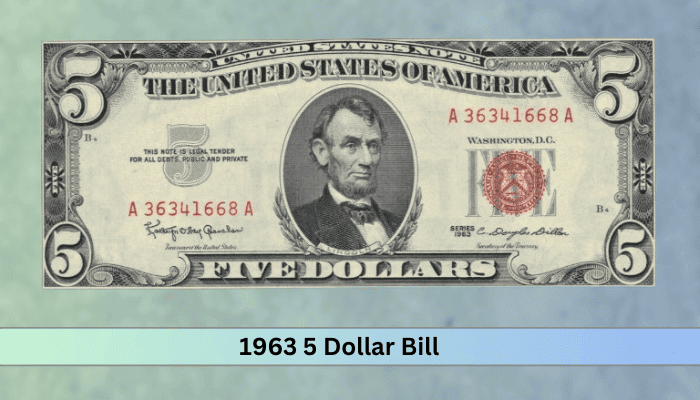Unveiling a Monetary Time Capsule
Picture this: A crisp, red-sealed $5 bill from 1963 resting in your hands – not just a piece of currency, but a portal into America‘s fascinating financial history. As a seasoned numismatist with decades of collecting experience, I‘ve witnessed countless stories hidden within these seemingly ordinary pieces of paper.
The Historical Tapestry of 1963 Currency
The year 1963 wasn‘t just another moment in American monetary history – it was a pivotal transition point. President John F. Kennedy was in office, the Civil Rights Movement was gaining momentum, and the United States monetary system was undergoing profound transformations.
Red seal bills represented more than simple currency; they were symbolic artifacts of a changing national identity. These notes, with their distinctive crimson seal, told stories of economic resilience, governmental policy, and cultural evolution.
The Intricate World of Red Seal Notes
When you hold a 1963 $5 red seal bill, you‘re not just holding money – you‘re holding a piece of meticulously crafted financial art. Each bill represents hours of intricate design, precise printing techniques, and complex security measures that were revolutionary for their time.
The red seal itself wasn‘t merely decorative. It signified a specific type of currency known as United States Notes, which carried unique legal tender status different from standard Federal Reserve Notes. These bills could be redeemed for silver, making them more than just paper – they were tangible promises of monetary value.
Decoding the Value: More Than Just Face Value
Understanding the true worth of a 1963 $5 bill requires more than a casual glance. Seasoned collectors like myself know that value is determined by a complex interplay of factors that go far beyond simple condition.
The Grading Symphony
Imagine each bill as a musical composition, where every crease, fold, and mark contributes to its overall harmony. Professional grading isn‘t just about assessing damage – it‘s about understanding the bill‘s entire lifecycle.
A bill in "gem uncirculated" condition isn‘t just pristine; it‘s a time capsule that has miraculously escaped the wear and tear of circulation. These specimens can command prices exponentially higher than their face value, sometimes reaching thousands of dollars.
Rare Variations: The Collector‘s Holy Grail
Not all 1963 $5 bills are created equal. Some variations are so rare that they‘re the stuff of collector legends. Star notes – bills with a star symbol replacing the standard serial number letter – represent manufacturing replacements and can be extraordinarily valuable.
Low serial numbers, particularly those under A00002000, become instant attractions for serious collectors. Each number tells a story – the first bills off the printing press, carrying historical significance beyond mere monetary value.
Serial Number Mysteries
Collectors develop almost mystical relationships with serial numbers. A bill with a perfectly sequential ladder (like A12345678) or a repeating pattern becomes more than currency – it becomes a collectible artwork.
The Technical Marvel of 1963 Currency Production
Behind every bill lies an incredible story of technological innovation. In 1963, the Bureau of Engraving and Printing was using advanced (for the time) offset printing techniques, creating security features that would have seemed like science fiction just decades earlier.
The paper itself was a marvel – a specialized blend of cotton and linen, designed to withstand years of handling while maintaining structural integrity. Each bill underwent rigorous quality control, with master craftsmen examining every minute detail.
Investment Potential: Beyond Nostalgic Collecting
While many view currency collecting as a hobby, seasoned collectors understand its potential as a nuanced investment strategy. A well-preserved 1963 $5 red seal bill isn‘t just a collectible – it‘s a tangible asset with potential appreciation.
Market trends show that rare, well-preserved bills from this era can see significant value increases. Some specimens have appreciated by hundreds of percentage points over decades, outperforming traditional investment vehicles.
Preservation: The Collector‘s Sacred Responsibility
Preserving these bills requires more than careful handling. It demands understanding environmental factors like humidity, light exposure, and potential chemical interactions.
Professional collectors invest in archival-quality storage solutions – acid-free sleeves, controlled environments, and minimal physical manipulation. Each interaction with the bill is treated with the reverence of handling a historical artifact.
The Human Connection in Collecting
Beyond technical details and monetary value, currency collecting is fundamentally about human stories. Each bill carries whispers of transactions, dreams, and moments in people‘s lives.
A 1963 $5 bill might have paid for a child‘s school lunch, purchased groceries for a growing family, or been part of a significant personal milestone. These aren‘t just pieces of paper – they‘re fragments of lived experiences.
Conclusion: A Living Historical Document
As you explore the world of 1963 $5 red seal bills, remember that you‘re not just collecting currency. You‘re preserving a moment in American history, a tangible connection to a transformative era.
Whether you‘re a seasoned collector or a curious newcomer, these bills offer a fascinating journey into the intricate world of numismatics. Each bill is a story waiting to be discovered, a treasure waiting to be appreciated.
Happy collecting, and may your passion for monetary history continue to grow!
